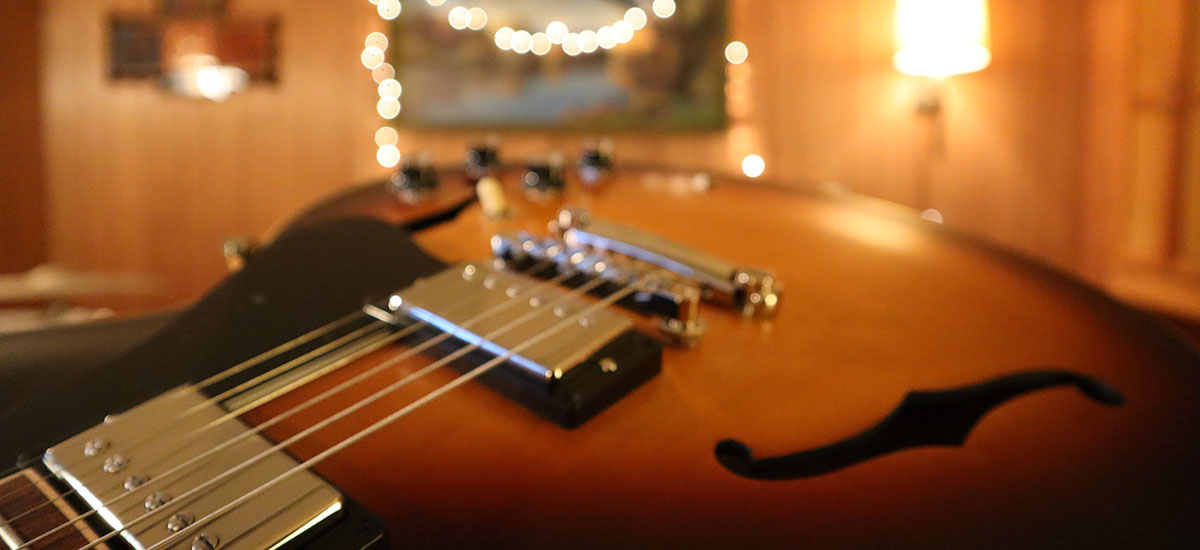One of the worst sounds to hear coming from your guitar is a warble that takes what should be clear notes and makes them sound like Chewbacca using a talk box. That warble sound occurs when there is interference in the even vibration of the guitar string. This interference introduces irregularities into the smooth vibration causing a lumpy, throaty sound that will drive anyone crazy.
The most common cause of guitar string warble is an electric guitar pickup that is adjusted too close to the strings. The magnet from the pickup interferes with the free movement of the string and will introduce non-musical oscillations in the guitar’s output. Jump to pickup height adjustment.
When diagnosing any strange sounds coming out of the guitar, start by eliminating variables. If you’re playing through an electric guitar, plug directly into the amplifier, removing all pedals between the guitar and amp. Put the amp on the cleanest possible setting. Now play slowly through all notes on the guitar. Are certain strings, notes, or areas of the fretboard worse than others? All of these things will give us hints on where to look to find the root of the problem.
Table of Contents
Beat Frequencies and Guitar Warble
This article addresses potential causes for guitar warble not produced naturally by two tones called beat frequencies.
Wikipedia defines a beat as, “an interference pattern between two sounds of slightly different frequencies, perceived as a periodic variation in volume whose rate is the difference of the two frequencies.” [wikipedia]
You’re very familiar with beat frequencies if you’ve ever tuned two guitars strings by ear. Fret the low E string on the fifth fret and compare that to the next string, the A. Both should be producing the same frequency, but if one is slightly different than the other you’ll hear this strange effect until you tune the string to match perfectly the other. When they are in tune, the beats go away, and so do the grating spine tingles.

This effect is also common when bending strings. If you’re playing bends on multiple strings, or bending one string into another that isn’t bent, you may start hearing these note wavers. It doesn’t necessarily need to occur between two fundamental tones. For example, one of the most common string bends on guitar is between the 3rd and 2nd strings. If, for instance, we’re in the key of E playing a minor pentatonic at the 12 fret, those notes are an A on the 3rd string, and a B on the 2nd. Bend the A up a whole step to the B and you’ll hear warbling as those two frequencies play off each other. The farther away the notes, the faster the beats. As the bended A gets closure to matching the B, the beats start to smooth out into a long slow waver.
When the human ear hears these beats, they create almost a tremolo effect where the volume appears to be increasing and decreasing quickly. This creates an unmistakable warble that can sound incredibly similar to warble from something else. Learning to identify each of these sounds will make you much better at diagnosing guitar issues in the future.
What is that guitar string warble sound?
The warble sound in a guitar’s output may also be described as a slow oscillation, a trill, or maybe even a wobble that distorts the guitar’s intentional sound.
While sympathetic resonance will typically add harmonic depth to a fundamental tone by adding frequencies of the octave, fifth, and major 3rd, what we’re hearing when our guitar warbles are non-musical frequencies and non-musical deformities in the expected response.
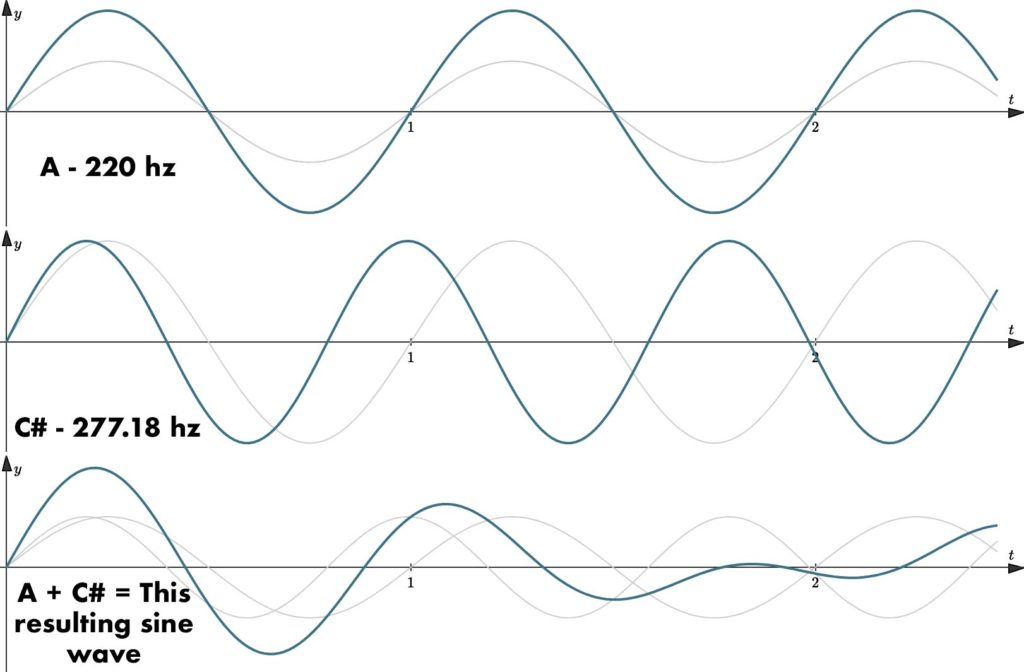
These irregularities can be caused by a physical interference of the string. They can also be caused by a non-physical magnetic interaction. Continue reading for diagnostic steps for both acoustic and electric guitars.
Before you spend too much time diagnosing a possible issue, how old are the guitar strings? A bad string can produce all sorts of weird sounds, so make sure you have a fresh set on before digging any further. Read here for how often you should change your guitar strings. Strange sounds, like warbling for instance, could quite easily be caused by a string that needs to be changed either because it’s old and at the end of its life, or because it’s defective and at the end of its life. The sooner you become ok with changing strings often, the better your guitar is going to sound and the more mature of a player you will become.
Now let’s dive into the various potential causes for a warble sound coming from your guitar.
Electric Guitar Warble
Pickup height too high
As mentioned above, the most common cause of string warble on electric guitars is a pickup or multiple pickups that are adjusted to be too close to the guitar strings. While adjusting the pickups close to the strings may seem like it would produce and fuller and higher output, too close has much the opposite effect.
There is a sweet spot where a pickup likes to be where you get the best tone, without negatively impacting the movement and sound of the string.
Read my guide Setup Like a Pro: How to Correctly Adjust Pickup Height on Electric Guitars
Active pickups need new battery
Active pickups work much in the same way that passive pickups do. However, they have a considerable number less coils than passive pickups. To make up for the lower output, a pre-amp powered by a 9v battery housed in the guitar body, amplifies the small signal and sends it out to the amp.
Active pickups are generally much less noisy than passive pickups, but suffer from a decreased dynamic range. The pre-amp boosts the signal and shapes it giving a great tone for specific applications like heavy rock and metal. If playing other genres that don’t utilize heavy distortion it’s most often better to stick with a passive pickup.
How do I know if my guitar has active pickups?
Active pickup systems run off of a 9v battery which provides power to the preamp. Without the 9v battery power, the guitar will sound extremely weak and quiet, or won’t produce sound at all.
Although not exclusively the case, most active pickup systems have pickup covers that cover the entire pickup without any pole pieces showing, much like this Jackson Randy Rhoads model RRX24.
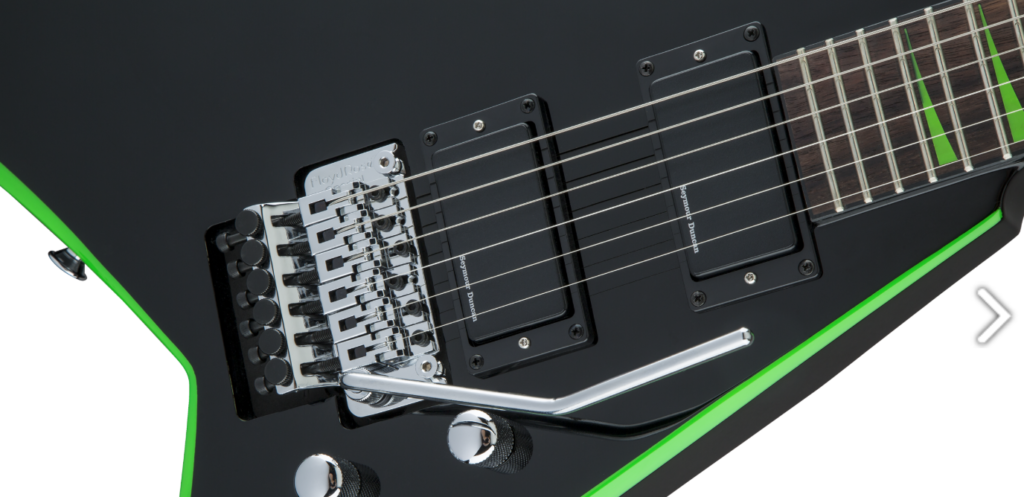
On many guitars that come shipped with an active system, there is a compartment already carved out of the guitar for the 9v battery it typically looks something like this, and is the most obvious give away that you have active pickups in your guitar. Here’s the back of that same Jackson Rhoads. Check out the 9v battery shaped door with the white sticker. That’s where the little juice box goes.

However some new guitars, and guitar that have had active pickups installed later, commonly hide the battery somewhere else. Look in the control cavity (access to the tone and volume pots). Looks also in the tremolo spring access panel as it can also be under there. On a hollow body (rare, but I have seen it before) the battery can often be found in an f-hole in a small pouch or on a clip just within reach.
Low battery power can not only lead to lowered output, but also weird artifacts in the overall sound and tone of the guitar. A warble is not out of the question if your battery is on its last legs. Try a fresh battery and see if that fixes the problem.
A guitar with an active pickup system utilizing a preamp is active as long as an instrument cable is plugged into the guitar. That means that the system is drawing power from the 9v battery. If you forget to unplug the guitar after you’re done playing it, you’ll come back to a guitar with a dead battery.
It doesn’t count to unplug the cord from the amp or effects pedals. You have to unplug the cord that is going into the guitar, as the active pickup system is on when a jack is plugged in.
Bridge saddle pinching string
Incorrectly cut, or worn out electric guitar bridge saddles will most often result in rattling, metallic sounds, but can also produce pinched harmonics in certain instances.
This can happen to all types of bridge saddles, but the most common are the Gibson style Tune-o-matic saddles. These are designed in a way where the strings sits in a precut “V” groove. While this typically doesn’t produce any issues, it can pinch the sides of the string in a way that causes a “pinch” harmonic.
Bridge pinch harmonics have the same effect has the screaming pinch harmonics of the 80s. These however are not clean and piercing, but annoying and buzzy. A quick easy way to determine if the bridge is causing an unwanted harmonic is to pull the string out of the bridge slot and place it right next to the slot but still on the saddle. Pluck the string again and see if the harmonic is gone. If it is, there’s your culprit.
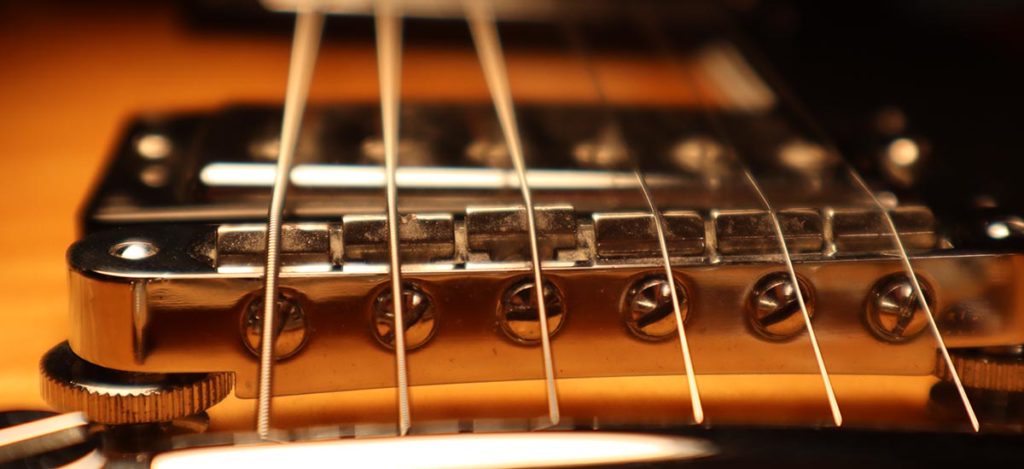
I file saddles with nut files, but if you’re not versed in this I’d take the guitar to a qualified repair tech. While the job isn’t difficult, if you take too much material off you have no choice but to replace the saddle or bridge.
Acoustic Guitar Warble
Pickup system needs a new battery
Similar to an active pickup system in an electric guitar, acoustic guitar pickups take a small output generated by a transducer or small microphone, and amplify that signal with a preamp. That preamp is almost always powered by a 9v battery. Much like an electric with a failing battery, low voltage in an acoustic guitar results in lack of overall sound and a changing of tone.
A low voltage battery can sometimes create a tremolo, or warble effect in acoustic guitar fitted with pickup systems.
Some acoustic guitar pickup systems have a battery access from the outside of the guitar. This is quite convenient and replacing the battery is as simple as popping out the old one and throwing a fresh one in its place.
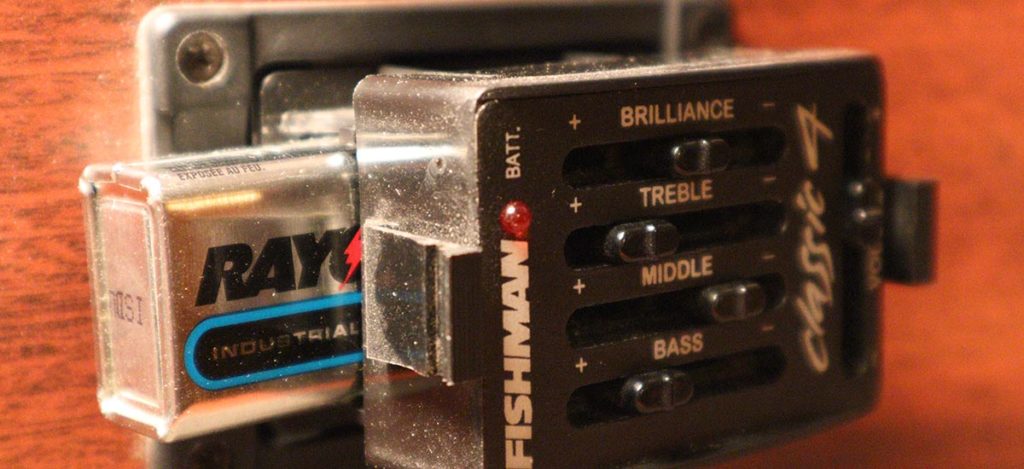
However, aftermarket and higher end acoustic guitar pickup systems often secure the battery in a small pouch that is tucked inside the guitar and often stuck to the neck block with strong adhesive.
When replacing the battery, first loosen all of the strings so that it is easy to reach your hand into the soundhole to grab the battery pack. Trust me, I’ve done enough of these where I thought I could get away without loosening the strings. Not only is it painful, but you could risk putting way too much pressure on the string and therefore the bridge of the guitar. Take the two minutes to loosen all strings. The back of your hand will thank you for it.
Reach into the guitar and find the battery pack. If it’s in a small pouch, pull gently at the pouch and listen for velcro. Most commonly, the small battery pouch has a velcro backing that matches with a velcro strip that is stuck to the neck block, back, or side of the guitar. Don’t pull too hard at first or you might pull the velcro backing off with it. The adhesive on those is pretty strong, so it in turn might pull some wood or other material with it if you’re not careful.
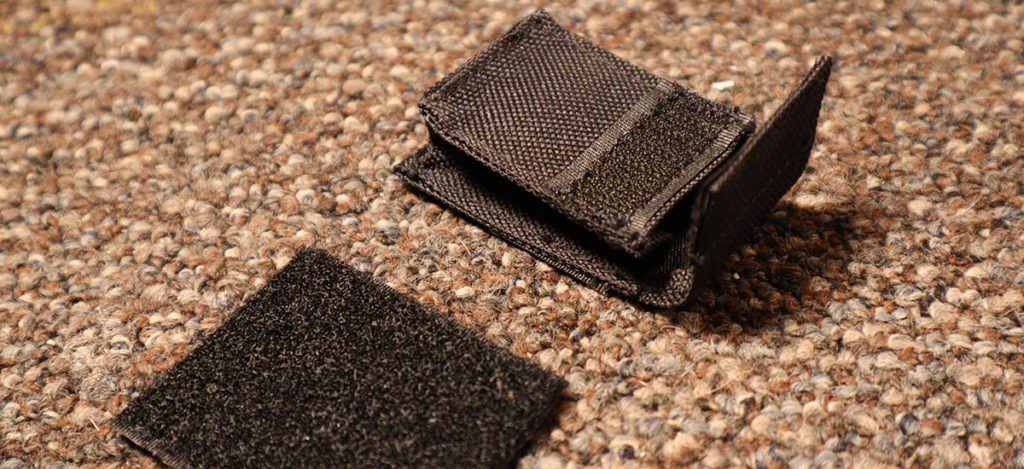
Again, make sure to only pull the battery and not the electrical wires going to it. It can be a pain to have to re-solder those small connections because someone got a bit rough when swapping out a battery.
Install the new battery in the reverse steps and bring the strings back up to tension.
Same with an electric guitar’s active pickup system, take care to unplug the instrument cable from the guitar every single time you’re done playing it. The preamp inside the guitar is running and drawing power from the battery as long as a jack is plugged into the guitar. It only takes one time forgetting and you’ll be coming back to a guitar with a dead battery.
Unplug your guitar every time you’re done playing it! This is a great habit to get in with all guitars that you play. Personally, I go in phases where I’ll play acoustic but not plugged into anything. Every once in awhile I’ll plug into my PA, or interface and I always used to forget to unplug the guitar which meant that I’d come back to a guitar with a dead battery. I started unplugging every guitar, even my electrics, when I was done and that habit has carried over to my acoustic. Now I never come back to a dead battery in my guitars!
Loose bracing, cracks, seam separation
Warble and other strange sounds can also be caused by parts of the guitar coming apart or separating where they should not be. Take the bracing inside of your acoustic. Those pieces of wood should be tightly glued and secured to the wood around it, the top, other braces, etc. If small gabs develop between the brace and the surrounding parts weird tones will be generated from those unwanted vibrations.
These can often be difficult to diagnose and find, but a qualified tech with a good light and a mirror can quickly find the cause of undesired noises coming from your guitar.
Sometimes you can determine if there are loose braces by holding the guitar neck and muting the strings. Now tap with your other hand around the top of the guitar listening carefully to the sound that is produced. You should hear a clear, woody tone that is resonant. You should not hear rattles or other non-musical sounds.
This method is also a great way to determine if pickup wires are seated properly. These are an often overlooked cause of unwanted noise in an acoustic guitar.
Top cracks and seam separation can also cause unwanted buzzing in a guitar. While top cracks are easier for the layperson to diagnose, fixing them and other acoustic structural issues should be done by a good repair tech. The better your guitar is hydrated and humidified the less chance there is of any of these issues popping up. Make sure you’re humidifying your guitar correctly!

Saddle cracks, wear, or not seated properly
Similar to certain electric guitar bridges, acoustic saddles can wear in weird ways resulting in unwanted harmonics in the string. Inspect the saddle and look for any obvious damage that looks like the saddle material splitting or crumbling. In rare circumstances that saddles can chip, creating a “V” that the string gets pinches into, resulting in pinch harmonics.
Typically if you’re having saddle issues this bad you’ll notice some wicked string buzz on the affected strings long before the pinch harmonics come. But hey, I can’t say I haven’t seen it before.
Pull the string over to a smooth area to the side where it normally runs over the saddle. Pluck the string again and listen for a change. If the warble, or rattle goes away then you have a saddle problem. The best course of action is most often to cut a new saddle. This process isn’t too expensive and a correctly cut saddle can make a huge difference in the tone of an acoustic guitar.
Improperly seated bridge saddle with an acoustic pickup
One of the most common types of acoustic pickup is the under-saddle transducer. This is a small strip of wire or flat element which sits underneath the saddle between it and the bottom of the saddle slot in the bridge.
A properly installed acoustic pickup will provide solid and even contact with the pickup element and the bottom of the saddle. If there is any variation in the evenness of the saddle bottom (or less commonly the bottom of the saddle slot in the bridge) then there will be issues with the output. Typically, the output will be inconsistent from string to string. However, a warble effect may be heard in some situations where the saddle width is either too loose causing vibration, or too tight causing weird harmonics or other muted tones.
A qualified tech can easily judge if a saddle is not installed properly.
General Guitar Warble
There are other scenarios common to both acoustic and electric guitars that could result in a wobble or warbling sound.
Old strings
I’ve mentioned this before, most recently in my visual step-by-step guide to changing acoustic guitar strings, that old strings are a common cause of your guitar making weird noises. As a guitar string ages, it becomes less consistent in the physical coil of the string which in turn causes a less consistent vibration of the string.
This inconsistent movement can be heard as a wobbling or warbling sound. As noted at the beginning of this article, the first step to diagnosing a warble in a guitar is to change your strings. Make sure you have a fresh set of strings on the guitar before starting down a diagnostic rabbit hole.
This is a pretty regular gripe of mine. If more players changed their strings more often, half of all guitar problems would go away. Well at least it keeps the repair guys in business!
Improperly cut, or worn out nut slots
Much like guitar saddles, the nut of the guitar is a common area for unwanted tones to crop up. The nut is a common culprit because it is, outside of guitar strings, the highest wear item on a guitar. Every guitar will need a nut replaced at some point in time, so don’t worry when it comes time for your guitar to have the operation.
Nuts are cut to allow a string to break correctly from the angle of the neck to that of the headstock and into the tuner. A nut slot that isn’t properly cut will often pinch the string resulting in weird, unwanted tones when strings are played open.
And that is how you tell if you need a new nut. Play the strings open, then play the same strings but fretting a chord. If the noise goes away then the problem is in the nut, if not that keep looking.
On the subject of repair, consider replacing the nut instead of just repairing it. You can create a concoction of nut powder and super glue which is dropped into the nut slot, allowed to dry, and then recut. While this method is effective, cheap, and works pretty well, it will wear faster than solid nut material and therefore should be seen as a short term fix. Of course, this is a great option for original nuts on vintage guitars.
Action too low causing the strings to hit frets when struck open
If the string height on the guitar is too low, then the string may hit a fret while it is vibrating. Again this interference will typically result in a harmonic that can create beats and sound metallic, buzzy, and even like a warble.
Low action is nice if you’re playing blazing fast runs, but can cause issues like unwanted artifacts from the string hitting frets.
High/low frets
Similarly, high and low frets can cause these types of unwanted sounds while playing around the neck of the guitar. If a fret is too low, and you’re fretting the string on that fret, then the next fret toward the bridge of the guitar is going to be too high and get in the way of the free movement of the string.
Fret problems can be incredibly frustrating and should only be handled by a qualified tech. You don’t want to start tinkering with frets and end up creating more problems than you started with, which is quite easy to do. If you’re suspecting fret problems take your guitar to your trusted repair tech and she’ll know what to do.
Conclusion
Diagnosing a warbling sound in a guitar can be frustrating, but this is a pretty comprehensive list of all of the common causes. First and foremost, make sure that you have a fresh set of strings on the instrument, then start going through this article.
Remember that the most common cause of warble is a pickup that is adjusted too close to the string. Before adjusting pickup heights however, make sure that the guitar is setup correctly, as pickup height adjustments are the last step when setting up a guitar.
If you are still having issues, or know of other causes for guitar warble, then please email me at tgp@theguitarpages.com.
